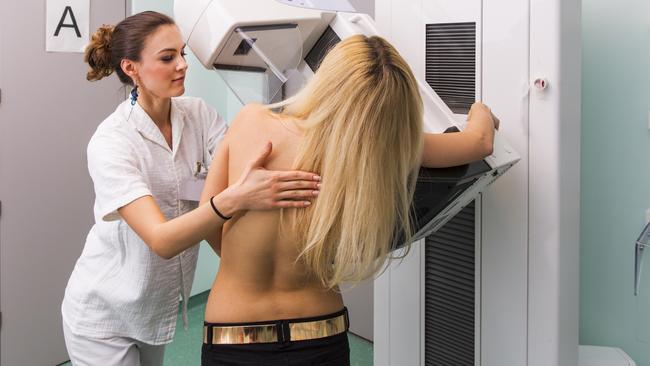Breast cancer: How healthy are your boobs?
HOW healthy are you boobs, REALLY? If you’re female, chances are you won’t be able to answer that question.
Body+Soul Daily
Don't miss out on the headlines from Body+Soul Daily. Followed categories will be added to My News.
HOW healthy are you boobs? If you’re female, chances are you won’t be able to answer that question.
That’s because only 15 per cent of Australian women are giving their breasts the attention they deserve.
New research from the McGrath Foundation suggests Australian women aren’t quite the “breast-perts” they think they are. The survey of 1288 women across the country aimed to measure levels of “breast-pertise”, which refers to the four pillars of breast health understanding: awareness, confidence in recognising changes, knowledge of risk factors for breast cancer and behaviour in terms of self-checking. It found that only 15 per cent of women in Australia met all four criteria, a statistic McGrath Foundation chief executive Petra Buchanan says is alarming.
The myths
While more than seven in 10 women believed they were somewhat or very breast aware, fewer than one in 10 could correctly identify six risk factors for breast cancer.
“This means that potentially there’s a substantial number of women who believe they’re breast aware, are confident in their ability to recognise changes and are checking their breasts for changes frequently — but are armed with incorrect information about what actually causes breast cancer,” Buchanan says.

It’s a scenario Karen Miles, a McGrath breast care nurse at Ipswich Hospital in Queensland, comes across daily: “There are so many myths around breast cancer. One of the most common ones is that breast implants increase your risk. They don’t. Or using deodorant will give you breast cancer. It won’t. And sunbaking topless. That might cause melanoma but it won’t cause breast cancer.”
The facts
Being a woman is the strongest risk factor for breast cancer, followed closely by getting older. For a woman in her 30s, her risk is one in 250. Those numbers jump to one in 30 if she is in her 70s. Family history also plays a part. Women with a mother, sister or daughter with breast cancer are twice as likely to develop the disease. Then there are lifestyle factors that can up a person’s risk, including having three or more alcoholic drinks per day and being overweight or obese.
As well as knowing these risk factors, women should be checking their boobs at least once a month. Miles says,
“As soon as you start to grow breasts, you should start getting to know them. Know what’s normal for you so that if you find something out of the ordinary — dimpling, lumps, bumps, an inverted nipple, discharge — you can have it checked. And make sure you do.
“We’d prefer to see you 10 times and find nothing than miss something once.”


Miles recommends spending a few minutes in the shower running your hands over your breasts, feeling for lumps, bumps and dimples, then checking them out in front of the mirror when you get out, looking for changes in colour, shape and size.
Not knowing how to self check is no excuse, Buchanan warns. “I often hear from people who aren’t sure they’re doing it right. That’s something they need to overcome.”
Only 25 per cent of Aussie women check their breasts once a month, according to the National Breast Cancer Foundation and HCF.
Mums need to speak up
Despite the fact a mother’s to-do list is usually endless, research suggests that raising the topic
of healthy boobs is a job best-suited to her — more so than health professionals and cancer patients. Still, only a quarter of Australian daughters have had that chat with their mum.
“This conversation isn’t happening often enough,” Buchanan says. “It’s important we change that because we now know that women who talk about breast health with their mother are twice as likely to have a similar discussion with their daughter.”

If mum’s not the word, throw it into the mix with your pals, Buchanan recommends. “When someone is diagnosed with breast cancer these days, there aren’t any inhibitions and we’re able to talk about it freely,” she says. “But when you’re surrounded by girlfriends, even if no one has been diagnosed, it’s about asking, ‘Hey, how can we take better care of our breasts?’”
SHERREE SELF, 45, MUM OF THREE
“My grandmother died of breast cancer so, from a very early age, my mum would drum into me the importance of self-checking. That’s something I now do with my girls. In November, 2007, I found a lump that turned out to be Stage 1 invasive cancer and the surgeon suggested I have a double mastectomy with reconstruction. Because I’d had breast cancer, my risk of developing ovarian cancer was higher so I had a total hysterectomy. That year was a pretty crappy one but I’ve been cancer-free ever since.”

What you need to watch for/The check
The National Breast Cancer Foundation says to see your doctor if you notice any of these changes:
1. The shower: Put your left hand behind your head. Using your fingers on your right hand, make small circular movements on your left breast. Feel lightly for anything near the surface then firmly to feel deeper. Continue in wider circles up to the collarbone and out to the armpit. Repeat on the other side.
2. The bathroom mirror: Place your hands by your sides and look for anything abnormal in the breasts – changes in colour, size or shape, dimpling of skin or the nipple. Then put your hands on your hips and push your chest forward and look again. Raise your hands over your
head and repeat the process.
3. Lying down: Lie flat on your back with your left arm under your head. Check your left breast using the method described in step 1.
Next, put your right arm under your head and repeat the process on your right breast.


